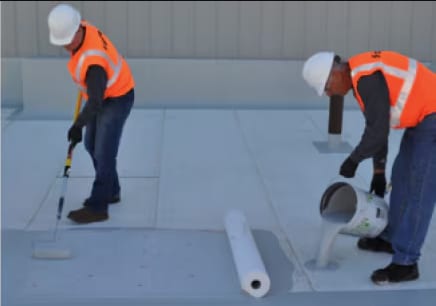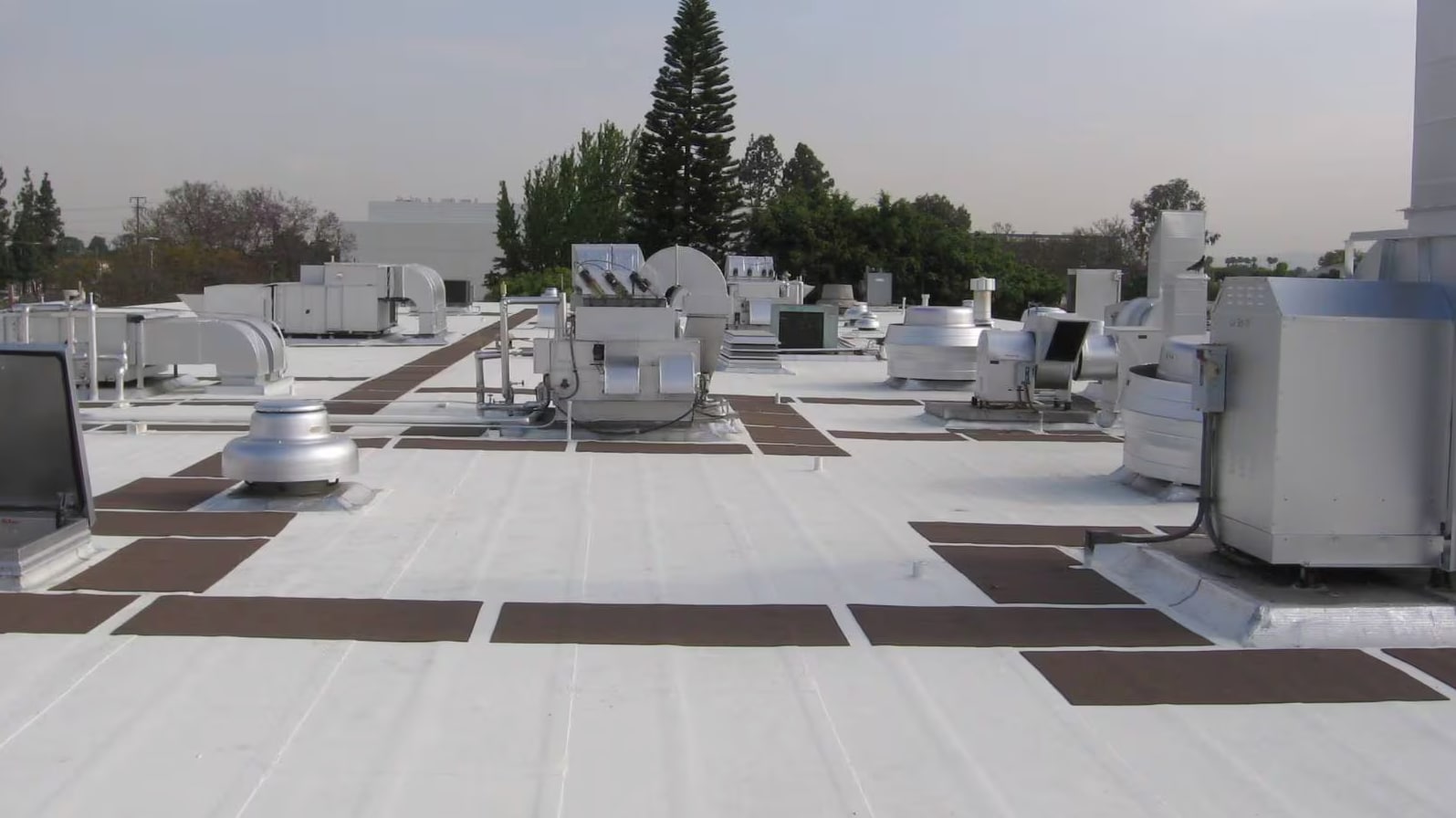Liquid-applied roof membranes (LAR) and roof coatings (aka, maintenance coatings) are not only here to stay, their use continues to increase.
Introduction
Liquid-applied materials have been used in the construction and roofing industries for a very long time. They have been made from many different materials--from beeswax and pitch some 5,000 years ago, to lacquers and varnishes just a couple thousand years ago, to our current polymer-based materials. The more viscous materials were used to keep water out of structures or to keep water storage and transport more leak-free. The less viscous materials are commonly used to coat or seal materials but not necessarily used to keep liquid water out (or in, for that matter).
According to the Roof Coating Manufacturers Association, "the most dramatic advance in coating properties has come in the past 40 years, with the development of polymers." Polymer-based coatings can be used on existing roofs, plaza decks, parking garages, balconies, and playgrounds, and most commonly provide reflectivity, UV protection, and an aesthetically pleasing surface. Inherently, because of the materials, coatings do provide a level of protection against water infiltration, but that is not their intended purpose.
Polymer-based liquid-applied membranes are primarily used as the waterproofing layer for new roofs, replacement roofs, roof re-cover systems, parking garages, plaza decks, balconies, and even interior spaces like mechanical rooms.

The common polymer-based materials include acrylics, PMMA, silicones, STP, and urethanes. Depending on the design intent and system configuration (e.g., reinforced) of polymer-based materials, they can be used to extend the life of an existing roof when used as a roof coating, or to provide a warranted or guaranteed roof or waterproofing membrane when used as a liquid-applied roof membrane.
Reasons for Increased Market Share
There are several benefits associated with liquid-applied roofs. The most commonly recognized benefits are:
When these materials are light-colored, they are likely reflective, which can help improve the energy efficiency of a building and reduce the urban heat island effect.
Using liquid-applied membranes can help extend time between roof tear-offs
The use of materials that can be applied at ambient temperature is welcomed by an installer. There are no hot-applied materials or open flames, which reduces certain safety issues.
Materials are typically provided in containers sized for easy transport to and from rooftops.
Common low-cost installation tools are used—rollers, brushes, squeegees, and simple, low-cost spray equipment.
Defining the Terms
One way to help sort out the difference between roof coatings and liquid-applied roof membranes is to understand current definitions used in the industry. The International Building Code (IBC) is a good place to start since it is a consensus-based document that provides the requirements for roofing and waterproofing.
International Building Code
The International Building Code does include a definition for coating but does not include a definition for liquid-applied membrane.
Roof Coating: A fluid-applied, adhered coating used for roof maintenance or repair, or as a roof covering system or assembly component.
IBC's definition of Roof Coating tells us four things:
Roof coatings are fluid-applied
Roof coatings are adhered
Roof coatings are used for maintenance or repair
Roof coatings can be a component of a 'roof covering system' or 'roof assembly' (which are the same according to ICC's definitions)
Roof Repair: is defined as reconstruction or renewal of any part of an existing roof for the purposes of correcting damage or restoring pre-damage condition.
Roof Covering System: is a Roof Assembly per IBC.
Roof Covering: is defined as the covering applied to the roof deck for weather resistance, fire classification, or appearance.
Roof Assembly: is defined as a system designed to provide weather protection and resistance to design loads. The system consists of a roof covering and roof deck or a single component serving as both the roof covering and the roof deck. A roof assembly can include an underlayment, a thermal barrier, insulation, or a vapor retarder.
As you can see, the information found in the Building Code is paramount to the confusion between Roof Coating and Liquid-applied Roof Membrane. Simply put, IBC's definition of Roof Coating does not really help differentiate between roof coatings and liquid-applied roof membranes. IBC does state that coatings are intended for maintenance and repair, but stops there. And per IBC's definition, coatings can be used for Roof Repairs to "correct damage or restore pre-damage condition," but that is not how coatings are generally intended to be used, so, again, more confusion.
Even though the definitions are not clarifying, the arrangement of Chapter 15 of IBC gives insight into IBC's perspective on roof coatings and liquid-applied roof membranes. Let's break this down. Section 1507, Requirements for roof coverings, has and continues to include all low-slope and steep-slope materials used as roof coverings that are recognized by the code. This includes materials such as asphalt, wood, and slate shingles, as well as modified bitumen and single-ply roofing (and myriad others). The IBC has always included a section specifically for liquid-applied roofing within Section 1507, but there has never been a section anywhere in Chapter 15 for coatings (until the 2021 IBC—more on that in a bit). To that end, the IBC is essentially saying liquid-applied membranes are categorized similarly to all other membranes that are used as roof coverings, and their intended use is for "weather resistance, fire classification or appearance". Because liquid-applied roof membranes are considered to be roof coverings by the IBC, roof systems that use a liquid-applied roof membrane need to be tested for fire, wind, and impact, just like any traditional membrane roof system. Logically, it can be concluded that liquid-applied roof membranes are the primary roofing membrane, not maintenance or repair items.
The liquid-applied membrane subsection within Section 1507 includes ASTM standards for materials not only used as liquid-applied membranes, but it includes the polymer-based materials (e.g., acrylics, polyurethanes, silicones) that are also intended to be used as coatings. This has often led to confusion within the code requirements, specifically how code officials would enforce the application of a coating product on an existing roof--as a new roof or as a maintenance item. To help with clarification and code enforcement for coating application, new language was added to the 2018 IBC in the Reroofing Section that stated a roof coating can be applied to (essentially) any existing roof without triggering reroofing requirements. Prior versions simply stated that coatings could be applied over an existing Spray Polyurethane Foam without removing any existing roofs. The improved language in the 2018 IBC is as follows:
"Section 1511.3, Roof Replacement. Exception 4: The application of a new protective roof coating over an existing protective roof coating, metal roof panel, built-up roof, spray polyurethane foam roofing system, metal roof shingles, mineral-surfaced roll roofing, modified bitumen roofing or thermoset and thermoplastic single-ply roofing shall be permitted without tear off of existing roof coverings."
The additional language in the 2018 IBC was a very important step in distinguishing between coatings and liquid-applied membranes.
As an important step in clarifying the differences between roof coatings and liquid-applied roof membranes, the IBC was revised in 2021. Specifically, a new section was added--Section 1509, Roof Coatings. This was an entirely new section, and importantly, Roof Coatings are not a subsection within Section 1507, Roof Coverings. This strengthens the differentiation from a code perspective that coatings are not considered to be a new roof covering. However, the 2021 IBC remains without a liquid-applied roof or membrane definition. The code ultimately relies on manufacturers' intentions for their products as the differentiating factor between roof coatings and liquid-applied roof membranes.
ASTM
Unfortunately and somewhat surprisingly, ASTM D1079, "Standard Terminology Relating to Roofing and Waterproofing," does not define roof coating or liquid-applied roof membrane.
FM Approvals
Liquid-applied roof membranes are considered to be roof coverings by the IBC, and therefore they must be tested as a roof system and have approval listings. Approval listings are used to show that these systems have been tested and comply with the code requirements for roof system properties like fire-, wind-, and impact-resistance.
RoofNav – New Construction
Performing a search using the Assembly Search function within FM's RoofNav software results in a number of Approval Listings for "Liquid Applied Systems" used for new roofs -- Siplast has 331 listings. There are 280 Parapro Approval Listings, 36 Paraflex Approval Listings, and 15 Terapro Approval Listings (as of June 27, 2023). Refer to RoofNav.com for specific assemblies. When a liquid-applied membrane is used as a roof covering or waterproofing membrane, a reinforcement, such as Pro Fleece or Pro Grid Reinforcement, is used between the top and base coats. There are myriad substrates and combinations of applications that are included as "new roofs" in RoofNav. For example, an assembly includes a top coat, a fleece reinforcement, and a base coat. Those components are installed over a torch-grade SBS-modified bitumen sheet over a gypsum-fiber roof coverboard. The assembly includes polyisocyanurate insulation mechanically attached to a steel deck.
It's important to recognize that an FM Approval Listing also provides information about the internal fire rating, exterior fire rating, and hail ratings. Many liquid-applied roof systems achieve Class A Exterior Fire ratings as well as Moderate or Severe Hail ratings. Refer to RoofNav.com for specific assemblies. For example, Siplast's RoofNav Assembly #450243-450204-0, can be installed up to a 2:12 slope, and has a Class 1 internal fire-resistance rating, a Class A external fire-resistance rating, a Severe Hail rating, as well as a wind uplift rating of 165 psf.
Need additional assistance? Connect with a representative Contact us
Simply put, roof coatings are used to provide protection from the elements and help extend service life of the existing roofing system. Roof coatings are not installed as membranes, so they are not intended to seal leaks or be considered "waterproof". To that end, manufacturers of roof coatings do not obtain approval listings for their coating products. Liquid-applied roof membranes are considered to be just that—membranes—and are used as the roof covering in new and re-cover roof systems. Liquid-applied roof membranes are tested as systems and have approval listings just like traditional asphaltic, modified bitumen, and single-ply roof systems.


